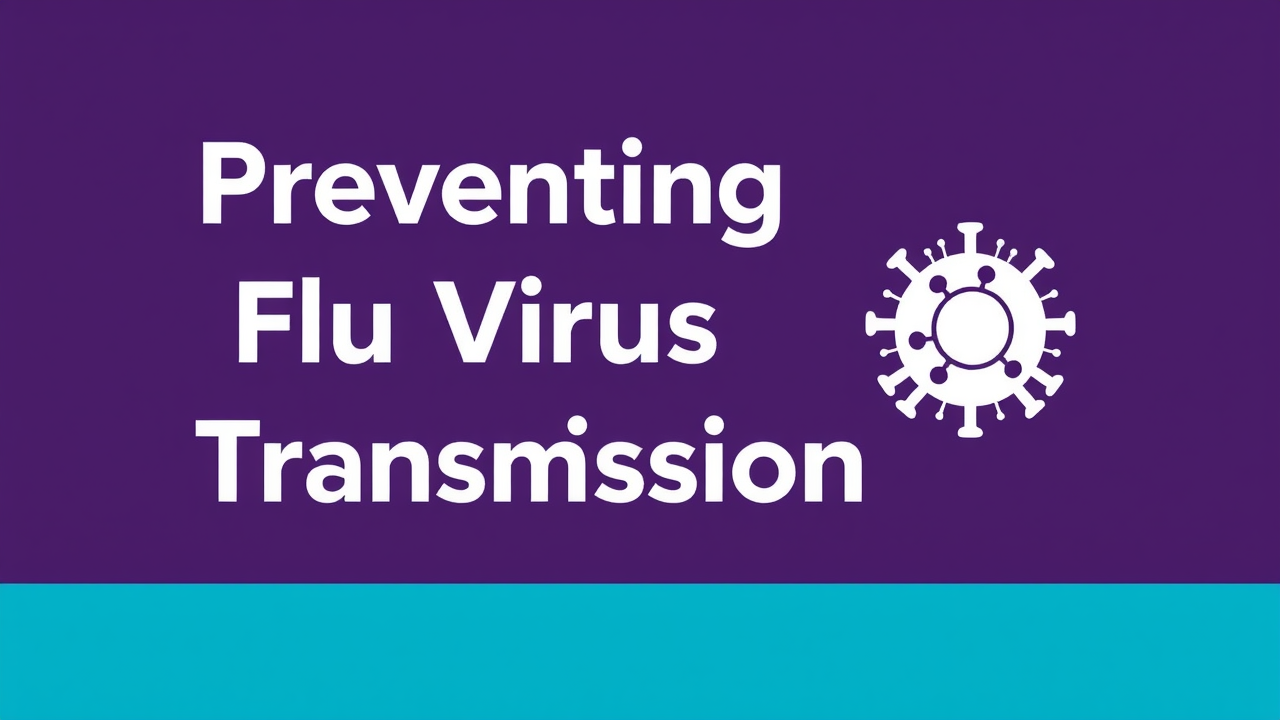Did you know that seasonal flu affects millions of people each year, resulting in hundreds of thousands of hospitalizations and tens of thousands of deaths worldwide?

Despite its reach, the flu is largely preventable through practical steps that protect you and those around you. In this in-depth guide, you’ll uncover the essential strategies to prevent flu virus transmission, safeguard your health, and help your community stay flu-free throughout the challenging months of flu season.
Startling Insights: Why Preventing Flu Virus Transmission Matters
"Each year, the seasonal flu leads to millions of illnesses, hundreds of thousands of hospitalizations, and tens of thousands of deaths globally—yet most cases are preventable."
Preventing flu virus transmission isn’t just about avoiding a few days of body aches or a runny nose; it’s about disrupting the cycle of a contagious respiratory illness that can be life-threatening, especially for those with compromised immune systems or chronic health conditions. The seasonal flu is more than a minor inconvenience—it can overwhelm health care systems, disrupt communities, and strain families. The majority of illness caused by influenza viruses is spread because basic preventive measures are not taken seriously.
Understanding the importance of prevention is a critical first step towards health. When you take proactive actions like getting the flu vaccine, practicing good hygiene, and staying home when you are ill, you not only reduce the risk for yourself, but become a powerful force in preventing the spread within your community. The flu’s effects extend far beyond personal discomfort—hospitalizations, missed work or school, and increased risk for those with health conditions. By making prevention a priority, including getting the flu vaccine and practicing good hygiene, you’re supporting community health and helping to reduce the risk of influenza virus spread.
The Current Scope of Seasonal Flu and Its Impact
During a typical seasonal flu period, it’s estimated that between 9 million and 45 million people in the United States alone contract the influenza virus. Globally, the World Health Organization (WHO) reports hundreds of thousands of deaths due to respiratory illness caused by influenza viruses each year. Many cases result in serious complications, especially for the elderly, very young, pregnant women, and those living with underlying health conditions such as asthma, diabetes, or heart disease. These groups are most susceptible to flu virus complications, including pneumonia and hospitalization.
The burdens of seasonal flu ripple through every aspect of society—from lost productivity at work to overburdened health care providers and emergency rooms. Children can rapidly spread flu viruses through schools, and it’s common for entire households to fall ill when basic hygiene measures aren’t observed. Despite annual reminders, many people remain unprotected by the flu shot or overlook simple steps that could stop the spread of germs. Recognizing the wider impact of the flu puts personal and collective health decisions into sharper focus.

What You'll Learn
Evidence-based ways to prevent flu virus transmission
How to reduce the risk for yourself and those around you
Best practices for maintaining health during flu season
Practical steps to prevent the spread of germs in various settings
Up-to-date insights on flu vaccines and health care advice
Understanding Flu Virus Transmission
How Does the Flu Virus Spread?
The influenza virus is a highly contagious respiratory illness spread using multiple pathways. Most commonly, the virus jumps from person to person through airborne droplets released when an infected individual coughs, sneezes, or even talks. These microscopic droplets can linger in the air of crowded public places or settle onto surfaces and objects where the virus can survive for hours. People frequently catch the flu by touching these contaminated surfaces—doorknobs, elevator buttons, or shared electronics—and then inadvertently touching their nose, mouth, or eyes.
It only takes a single exposure for the flu virus to find its next host. Because infected individuals can be contagious even before symptoms appear, it’s easy for the virus to spread in homes, workplaces, and schools. The risk of transmission rises dramatically in closed or crowded settings such as public transportation, offices, or big gatherings. Recognizing how the flu is transmitted is the foundation for sensible prevention—focusing on behaviors and environments that either hinder or facilitate the journey of the virus from one host to the next.
Understanding the mechanisms of flu transmission is crucial, but it's equally important to recognize how underlying health conditions can influence your vulnerability to respiratory illnesses. For a deeper look at how chronic diseases may impact your risk and what proactive steps you can take, explore these key insights on managing health with conditions like AL Amyloidosis.
Factors That Increase the Risk of Flu Transmission
Several factors make it easier for the flu virus to move through a population. Close contact in crowded places, such as subways, schools, or events, increases exposure. Poor ventilation allows airborne droplets to linger, and touching shared surfaces further boosts the possibility of catching the flu. Individuals with weakened immune systems—due to age, existing health conditions, or medications—are at greater risk. In addition, inconsistent hand hygiene and poor habits like touching your face or not covering a cough or sneeze contribute to the rapid spread of contagious respiratory illnesses like the flu.
The flu also spreads more easily during certain times of year. Cold weather brings people indoors, increasing close contact. The flu season typically peaks from late fall to early spring, coinciding with school semesters and holiday gatherings. Being aware of these risk factors lets you make informed decisions about how to reduce the risk for yourself and those around you—especially by improving hygiene and staying vigilant during peak transmission periods.

Mode of Spread |
Example Situations |
|---|---|
Airborne droplets |
Sneezing, coughing |
Surface contamination |
Shared objects |
Close contact |
Crowded spaces |
Key Strategies to Prevent Flu Virus Transmission
Get Vaccinated: Importance of the Flu Vaccine
"The flu vaccine not only protects you but also reduces the risk of spread within the community—even among those who can't be vaccinated due to health conditions."
Receiving the annual flu vaccine (or flu shot) remains the most effective way to prevent flu virus transmission during the seasonal flu period. The vaccine is reformulated every year to match the most common influenza viruses in circulation, offering robust protection against severe illness. Not only does it help keep you healthy, but widespread vaccination creates community immunity—making it harder for the virus to travel, especially to the most vulnerable. For those with underlying health conditions or weakened immune systems, getting vaccinated can be a literal lifesaver.
Health care providers recommend that everyone over six months old receives the flu vaccine each year, especially older adults, pregnant women, children, and individuals with chronic diseases. If you’re worried about side effects, rest assured that the flu shot is safe and often results only in mild symptoms like a sore arm or low-grade fever. Because people can spread the flu even before symptoms appear, vaccination remains the best preemptive action to both protect yourself and prevent the spread of germs throughout your community.
Practice Good Hygiene to Reduce the Risk
Hand hygiene is your frontline defense against influenza and other contagious respiratory illnesses, significantly helping to reduce the risk of flu virus transmission. Washing your hands frequently with soap and water for at least 20 seconds removes infectious material. When you’re out and about without immediate access to a sink, an alcohol-based hand sanitizer can offer quick protection. Always avoid touching your face—especially your eyes, nose, and mouth—unless your hands are freshly washed. Because flu viruses can linger on touched surfaces like doorknobs, phones, or computer keyboards, vigilant hygiene helps reduce the risk of contracting and spreading the virus.
Frequent hand washing
Use of hand sanitizers
Avoid touching face with unwashed hands
Proper hygiene practices don’t stop there. Covering your mouth and nose with a tissue or the crook of your elbow when you cough or sneeze keeps droplets from dispersing into the air. Dispose of tissues promptly and sanitize your hands afterward. This simple behavior greatly helps in preventing the spread of germs by keeping them out of the shared environment, especially in public places where the risk of transmission is highest during flu season. Good hygiene isn’t just a courtesy—it’s a proven, lifesaving routine.

Stay Home When Sick to Prevent the Spread
If you’re feeling ill—whether you have body aches, fever, cough, or other signs of a respiratory illness—the best way to prevent flu virus transmission is to stay home and avoid contact with others. This advice, often overlooked, is one of the most effective tools to prevent the spread of influenza and other viruses. When people go to work, school, or public events while contagious, it allows the virus to travel quickly through communities. By staying home at the first sign of illness, you protect both yourself and those around you, especially people with weaker immune systems or serious health conditions.
You should remain home until at least 24 hours after your fever subsides without the use of fever-reducing medications. Rest and recovery are crucial—not just for your own well-being, but to stop the chain reaction that leads to widespread outbreaks. This approach is doubly important during the peak of flu season and in settings with vulnerable individuals. Remember, responsible choices like staying home from work or school can save lives by breaking the cycle of flu virus transmission.
Clean and Disinfect Common Surfaces Regularly
Viruses such as influenza can survive on hard surfaces for up to 24 hours, creating ample opportunity for indirect transmission. That’s why it’s critical to regularly clean and disinfect high-touch areas at home, daycare, schools, or the office. Focus on frequently touched surfaces like doorknobs, light switches, countertops, bathroom fixtures, phones, and keyboards. Use EPA-approved disinfectants or simple household cleaning sprays proven to kill influenza viruses.
Being diligent about disinfecting these “hot spots” dramatically reduces the risk of virus transfer from surfaces to people. In shared spaces, it’s wise to coordinate regular cleanings, and at home, step up your routine during flu season, especially if a loved one is sick. Cleanliness not only helps prevent the spread of flu virus transmission, but also protects against a range of other germs that cause illness.

Use Face Masks and Cover Coughs/Sneezes to Limit Spread of Germs
Face masks are especially effective in crowded public settings or when you’re at higher risk of spreading or contracting the flu virus during seasonal flu outbreaks. Masks help block infectious respiratory droplets, protecting not only you but also those nearby who might have compromised immune systems or chronic health conditions. Even in household settings, mask-wearing is recommended if someone is sick with the flu virus, especially if you share living space with elderly people, young children, or anyone with underlying health issues.
When you don’t have a mask, always use a tissue or your sleeve—not your bare hands—to cover your mouth and nose when coughing or sneezing. These practices are both personal and community-minded, helping to stop the spread of germs at its source. Adopting these habits, especially during the peak of flu season, makes a real difference in preventing flu virus transmission in both public and private spaces.
Taking Care: Protecting Yourself and Others
Supporting Vulnerable Populations: Those with Health Conditions
Some people face significantly higher risks if they contract the flu—especially older adults, infants, pregnant women, and those with health conditions like heart disease, asthma, or diabetes. For individuals with weakened immune systems, the flu can trigger severe complications or even become life-threatening. That’s why preventing flu virus transmission is a shared responsibility; you’re not just protecting yourself when you take preventive steps, but also those around you who might not be able to mount a strong defense.
If you or a loved one falls into a “vulnerable” category, extra precautions are essential. Encourage others in your community to get the flu vaccine, follow hygiene and cleaning protocols, and stay home when sick to prevent flu virus transmission. These efforts are particularly important for families and caregivers who interact with at-risk individuals on a daily basis. Proactive prevention supports community resilience, health, and quality of life for all.

Consult Health Care Providers for the Best Advice
If you’re unsure about the best preventive strategies, possible contraindications for the flu vaccine, or managing a specific health condition, consult a qualified health care provider or family doctor for personalized advice. They can offer tailored recommendations based on your personal medical history, current medications, and lifestyle. Health care professionals have up-to-date knowledge about the yearly strains of the influenza virus, vaccine efficacy, and strategies to reduce the risk of infection.
People living with chronic health conditions should maintain regular check-ups and discuss any concerns about flu virus transmission, whether it’s in community settings, schools, or public places. Your care provider may suggest additional precautions or early interventions if you’re considered high-risk. Proactive communication with your health team is a key way to protect yourself, optimize your strategies, and maintain overall wellness during the flu season.
When to Seek Help from a Health Care Provider
While most healthy individuals recover from the flu with rest and supportive care, certain warning signs require prompt medical attention. Contact your care provider immediately if you experience shortness of breath, chest pain, persistent high fever, confusion, or severe body aches that do not improve. For anyone with chronic health conditions, flu symptoms can escalate quickly. Early intervention is critical to prevent severe complications like pneumonia, dehydration, or worsening of pre-existing illnesses.
Children, pregnant women, the elderly, and those with weakened immune systems should have a low threshold for seeking professional care. Don’t wait for symptoms to become extreme—acting fast leads to better outcomes, helps your recovery, and lessens the risk of exposing others in community or home settings. Staying connected with your health care provider could truly make a life-saving difference during flu season.

Lifestyle Changes That Help Prevent Flu Virus Transmission
Boosting your immune system through nutrition
Regular physical activity
Managing stress levels
Ensuring adequate sleep
Building up your body’s natural defenses is a powerful way to keep the flu at bay. A balanced diet rich in fruits, vegetables, lean proteins, and whole grains strengthens your immune system. Regular exercise keeps your immune response robust, while good stress management bolsters resilience against infections. Equally important is prioritizing sleep—adults need at least 7–9 hours nightly to stay fit and alert. These healthy habits amplify the effects of other preventive tactics and lower your risk of severe outcomes if you do catch a flu virus.
When you combine these lifestyle changes with vaccination and good hygiene, your body is fully equipped to combat contagious respiratory illnesses throughout flu season. Encouraging friends, family, and colleagues to adopt these behaviors can transform entire communities, making yearly outbreaks less severe and more manageable.
People Also Ask
How can flu transmission be prevented?
Comprehensive preventive measures include vaccination, maintaining hand hygiene, avoiding close contact with sick individuals, regular disinfection of surfaces, and staying home when experiencing symptoms.
To effectively prevent flu virus transmission, it’s essential to take a multi-pronged approach: get your flu shot annually, keep your hands clean, minimize exposure in crowded public places, and stay home at the first sign of illness. Diligent cleaning and using masks in high-risk settings are valuable additions. These combined measures break the chain of person-to-person spread, especially during flu season.
Can you be around someone with flu and not get it?
Yes, with proper preventive strategies such as hand washing, using face masks, and getting vaccinated, it is possible to minimize your risk even if you are around someone with the flu.
If you must interact with someone who is ill, practice careful hand hygiene, wear a face covering, and avoid direct contact. Use separate utensils and towels, and increase ventilation if indoors. Effective prevention depends on consistent hygiene, limiting exposure, and supporting immunity with rest, good nutrition, and vaccination.
How to prevent getting the flu if someone in your house has it?
Isolate the infected individual, ensure frequent disinfection of surfaces, use separate personal items, and maintain strict hand hygiene to reduce the risk for other household members.
Create a dedicated space for the sick person, disinfect commonly touched surfaces daily, and provide easy access to tissues, hand sanitizers, and wastebaskets. Family members should minimize direct contact, wear masks, and wash their hands thoroughly and frequently. These steps help prevent the spread of the influenza virus within households.
How to prevent the spread of the influenza virus?
By covering coughs and sneezes, disposing of tissues properly, wearing masks, and adhering to vaccination recommendations, you help prevent the spread of the influenza virus within communities.
Personal responsibility is at the heart of seasonal flu control. Everyone plays a part by keeping hygiene top of mind and advocating for vaccination. Even small steps—like regularly washing your hands or covering sneezes—significantly reduce the risk to yourself and your wider community.

FAQs: Your Top Questions on How to Prevent Flu Virus Transmission
Is the flu vaccine effective against all types of flu? The annual flu vaccine targets the strains most likely to circulate in each flu season, but no vaccine offers 100% protection. However, it significantly reduces illness severity and chances of severe complications.
What should I do if I have a health condition that limits vaccination? Speak with your health care provider to discuss alternative preventive strategies, including antiviral medications and strict hygiene measures.
How long should I stay home with flu symptoms? Stay home until at least 24 hours after your fever is gone without the use of medications. This helps prevent spreading the virus to others.
Are there additional precautions during seasonal flu outbreaks? During seasonal flu outbreaks, increase cleaning routines, wear masks in crowded public places, and follow public health guidance to effectively reduce the risk of flu virus transmission.
Key Takeaways: Prevent Flu Virus Transmission Effectively
Flu vaccination remains the cornerstone for prevention
Good hygiene and staying home when sick are crucial
Protecting those with health conditions is a community responsibility
Proactive measures can reduce the risk and spread of germs
Conclusion: Act Now to Prevent Flu Virus Transmission
Your Commitment to Health During Seasonal Flu
This flu season, make a commitment to protect yourself and your community. Small actions—like vaccination, consistent hygiene, and compassion for those at risk—add up to substantial protection against the spread of the influenza virus.

Take Action: Begin Preventing Flu Virus Transmission Today
"Proactive prevention not only keeps you healthy, but safeguards your community from seasonal flu."
Start now: schedule your flu shot, refresh your hygiene habits, and check in on vulnerable friends or family. Together, we can prevent flu virus transmission and keep our communities safer all flu season long!
If you’re inspired to take your wellness journey even further, consider how nutrition and lifestyle choices can strengthen your immune system year-round. Discovering the healthiest foods for your body—especially during critical times like early pregnancy—can make a significant difference in your overall resilience. For practical guidance on nourishing your body and supporting long-term health, explore this comprehensive guide to the healthiest foods for early pregnancy and optimal nutrition. Investing in your daily habits today can help you stay strong and protected, no matter what the season brings.
Watch this short, engaging visual guide to see effective habits—like hand washing, mask-wearing, and disinfection—in action. Learn how simple changes can help prevent the flu in real-world situations.
Discover the most important steps to keep influenza viruses at bay—this video breaks down hand hygiene and the importance of annual flu shots for the whole family.
Sources
WHO – https://www.who.int/news-room/fact-sheets/detail/influenza-(seasonal)
Mayo Clinic – https://www.mayoclinic.org/diseases-conditions/flu/expert-answers/faq-20057907
To further enhance your understanding of flu prevention, consider exploring the following authoritative resources:
The Centers for Disease Control and Prevention (CDC) provides comprehensive guidelines in their article, Healthy Habits to Prevent Flu. This resource outlines essential practices such as vaccination, hand hygiene, and respiratory etiquette to minimize flu transmission.
The Mayo Clinic offers insights on the role of masks in flu prevention in their article, Flu mask: Should I wear one?. This piece discusses scenarios where mask usage is beneficial and provides guidance on other preventive measures.
By consulting these resources, you can gain a deeper understanding of effective strategies to prevent flu virus transmission and maintain your health during flu season.
 Add Row
Add Row  Add
Add 




Write A Comment